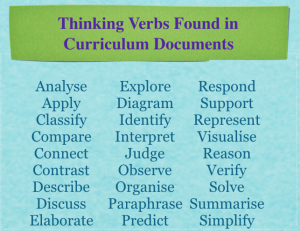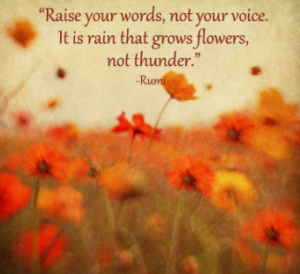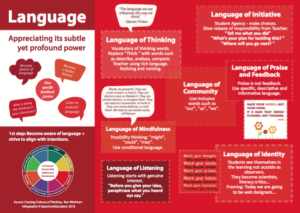The Power of Language
The words we use have a subtle and powerful ability to shape thinking, a sense of self and group affinity according to Ron Ritchhart in his book Creating Cultures of Thinking. He outlines 7 ways in which language shapes the culture of a classroom and school, and directs attention and action.
1. The Language of Thinking
What is thinking? How would you define thinking? When you ask your students to, “Think about it”, “Put their thinking caps on”, “Share their thoughts” what do you hope they will do inside their heads? Reflect, connect, analyse, create, associate…? If you want students to be great thinkers it is important to notice and name the thinking they are doing. Processes that have a label are much easier to repeat. In fact, language and thought are totally intertwined – you cannot have one without the other- the richer the language base, the higher the quality of the thought.

On the right is a list of many of the thinking verbs found in your curriculum documents. This would suggest these are the thinking processes that your learners should be able to use at a conscious level. There is a big difference asking students to: “Let’s look at these two pictures.” and “Let’s compare these two pictures.” The latter suggests a clear thinking strategy. Of course these thinking processes require explicit teaching with thinking maps and tools. Ensure you label the thinking rather than the name of the map or tool. For example, when teaching students how to compare and contrast you may use a Double Bubble Map. Rather than calling the map by name, work towards calling it by the thinking the map promotes, a compare and contrast map.
Challenge yourself in the next few weeks to notice every time you say the word ‘think’ and pause and replace it with the kind of thinking you would like students to engage in.
2. The Language of Identity
 One of the dynamic parts of language is how our words can bond and cause connection between humans. Who do your students see themselves as a learner? Do they perceive that education is being ‘done’ to them or that they are part of the process? Your language can raise the identity of your students. A simple idea is to name your class. Instead of calling then Room 4, you might call them a ‘Room 4 Thinking Family’ or ‘Room 4 the place to stretch and grow.’ At Wynnum State Primary School students are known as ‘Wynnum Warriors’ alongside their school motto: “We BELIEVE, we ACHIEVE and SUCCEED”.
One of the dynamic parts of language is how our words can bond and cause connection between humans. Who do your students see themselves as a learner? Do they perceive that education is being ‘done’ to them or that they are part of the process? Your language can raise the identity of your students. A simple idea is to name your class. Instead of calling then Room 4, you might call them a ‘Room 4 Thinking Family’ or ‘Room 4 the place to stretch and grow.’ At Wynnum State Primary School students are known as ‘Wynnum Warriors’ alongside their school motto: “We BELIEVE, we ACHIEVE and SUCCEED”.
To create the identity of the roles students play in their learning use phrases such as “Today you are going to be web designers …” , ” As an influential journalist…” or “You will be required to look with the eyes of a scientist…” This signals to the learners that they are required to think in relevant ways.
3. The Language of Community
Dove tailing the idea of identity is the capacity of language to create community. Do you say, “I want you to…” or “We are going to…”. The use of the pronouns our, we and us create the idea that everyone is ‘in this together’, and we are a team, rather than learning is an individual pursuit and maybe even a competition between class members.
4. The Language of Mindfulness
Language can assist your learners to be more aware, mindful and flexible. Using conditional language such as might, could or may can open up possibility thinking. This means students do not feel the same pressure to be correct, rather that their responses can be more varied. It is the difference between saying, “What might be some of the materials boats are constructed from?” or “What are boats made from?” The language of the second question portrays a correct answer is required (the word ‘are’ is absolute language), while the first question opens up the possibility for a variety of ideas to be shared and the word ‘might’ suggests the answer does not have to be correct (conditional language).
5. The Language of Listening
 Listening starts with a genuine interest in what another person is expressing. It is one of the powerful ways to show respect. Stephen Covey, author of the Seven Habits of Highly Effective People, made famous the expression “Seek first to understand, then to be understood. To be a great listener it requires being able to put your own thoughts aside to truly understand the other person. Good listeners pause to hear, paraphrase in an attempt to understand another point of view and ask authentic questions to clarify points and inquire for further depth and understanding.
Listening starts with a genuine interest in what another person is expressing. It is one of the powerful ways to show respect. Stephen Covey, author of the Seven Habits of Highly Effective People, made famous the expression “Seek first to understand, then to be understood. To be a great listener it requires being able to put your own thoughts aside to truly understand the other person. Good listeners pause to hear, paraphrase in an attempt to understand another point of view and ask authentic questions to clarify points and inquire for further depth and understanding.
Phrases you could use in the classroom include, “Before you give us your idea, please can you paraphrase what Duncan said.” or teach students to use structures such as “Shelley’s idea is… but Cathryn believes… and I conclude that…”
6. The Language of Praise and Feedback
To raise the quality of your learners work, high quality feedback and praise is required. A major key to this is ensuring the praise and feedback is specific, descriptive and informative. Telling your learners they are a “good boy”, “well done”, “awesome job” or “exactly right” has little impact other than letting students know they have been compliant and correct. Carol Dweck suggests that “praise is intricately connected to how students view their intelligence.” She goes on to say, simply praising a learners ability may produce a burst of pride but ultimately be detrimental to learning.
Praise and feedback of specific repeatable behaviours or information which is actionable and directly related to the task at hand is recommended. To encourage ongoing learning and improvement phrases such as “Your persistence of the challenging task has paid off”, “Your attention to detail and risk taking of trying a new idea has resulted in a quality piece of work” or “You used all the facts and came up with a clever new idea.”
Austin’s Butterfly video (below) showcases a wonderful example of how specific and descriptive feedback results in a higher quality of work.
7. The Language of Initiative
The language you use is just as important to enable student agency. A slow release of responsibility from the teacher comes with skilful questioning. Rather than having learners show you the final product, ask “tell me what you did” or “where will you take this next?” When students have a challenge or are faced with uncertainty, empower them with a question such as “What’s your plan for tackling this?” Encourage your learners to be the thinkers in the classroom, rather than the teaching taking the thinking role. Become an empowering questioner to assist learners to take the initiative and become more independent and self-directed is a key task of a great teacher.
Actions for you…
- Become more aware of the language you are using each day. You might either video yourself teaching in your classroom, or have a colleague observe you and analyse your use of language
- Listen to the language of your students. Are they using absolute language or conditional/possibility thinking language?
- Practice giving specific, informative praise and feedback to your learners
- Model active listening
- Empower your learners to solve their own challenges and problems, rather than doing the thinking for them.

To download a complimentary copy of this infographic please click here
** This article is the second in a series of 8, focusing on the 8 Cultural Forces and Cultures of Thinking.
Want to know more?
To join the webinar series please go to www.spectrumeducation.com/cultures-of-thinking-webinar-series or contact us for information about the recorded videos from this series.
To purchase and download all 8 posters please go to www.spectrumeducation.com/cultures-of-thinking-infographics/
Tags: 8 Cultural Forces, CoT, Cultures of Thinking, Karen Tui Boyes, Power of Language
Published on Tuesday, April 3rd, 2018, under Cultures of Thinking, Teacher Effectiveness
